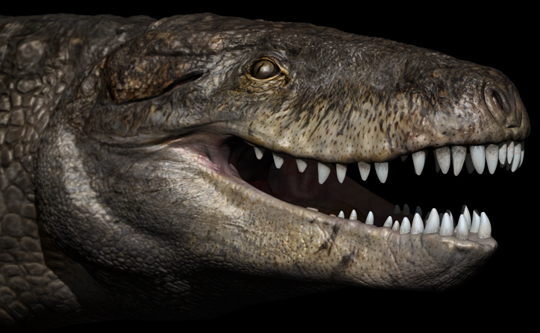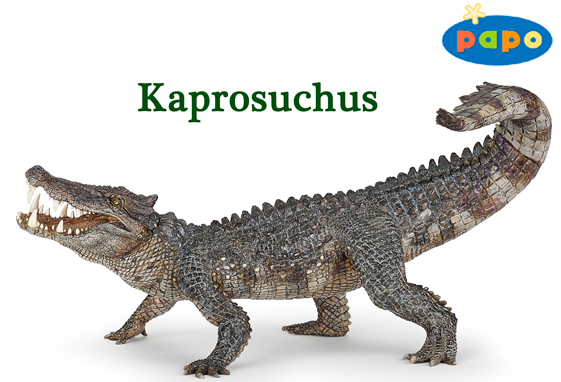Razanandrongobe sakalavae – Terror of the Middle Jurassic
A team of French and Italian palaeontologists have pieced together a more than decade-long puzzle and as a result, have come face to face with one of the most nightmarish prehistoric animals imaginable. New research on fossils found in north-western Madagascar has led scientists to describe a giant, terrestrial crocodile with immensely strong teeth and bone-crushing jaws. The new species, the largest and oldest Notosuchian described to date, may well have filled the apex predatory niche in this part of the southern, super-continent Gondwana. The super-sized croc, named Razanandrongobe sakalavae (pronounced Ray-zan-an-dro-go-bay sack-ah-lar-vey), had teeth reminiscent of the robust teeth of a Late Cretaceous tyrannosaur.
Indeed, an examination of the denticles (serrations) on the teeth preserved in the left dentary fragment and partial right premaxilla are strikingly similar to the serrations on a T. rex tooth.
A Reconstruction of the Deep Skull of Razanandrongobe sakalavae
Picture credit: Fabio Manucci
Archosauria incertae sedis
In 2006, three palaeontologists (Simone Maganuco, Cristiano Dal Sasso and Giovanni Pasini), published a scientific paper that described a large predatory archosaur from the Mahajanga Basin of Madagascar. The animal was named based on a fragmentary right maxilla and seven isolated teeth. It is not unusual to have a new genus established based on such incomplete remains, however, what kind of reptile these fossils represented was very much open to debate. Could it have been a crocodylomorph or perhaps a carnivorous dinosaur? A new taxon was erected Razanandrongobe sakalavae, in the 2006 paper.
It was suggested that the fossils might represent the largest predatory animal known from the Bathonian faunal stage of Jurassic Madagascar and that it could have been durophagous – feeding on hard materials like the bones of other vertebrates. Such was the paucity of the fossil material, that although the species name entered scientific literature, it was referred to as “Archosauria incertae sedis”, which means it was a member of the Archosauria, but where it belonged in this large and extremely diverse clade was anyone’s guess.
More Fossils – More Skull Material
Writing in the academic journal “PeerJ” the same researchers, in collaboration with Guillaume Fleury (Muséum d’Histoire Naturelle de Toulouse, France), have described more cranial material including an almost complete right premaxilla, a portion of left lower jaw bone (dentary), plus a partial maxilla complete with unerupted teeth and a single, very large broken tooth. In addition, a further five skull bones, that were, most likely collected from the same location are also assigned to R. sakalavae. These fossils have ruled out Theropoda, Razanandrongobe was definitely from the Crurotarsi archosauriforms and as such, it has affinities with today’s crocodilians.
However, phylogenetic analysis assigns Razanandrongobe to the Notosuchia and as such, it was very distantly related to Kaprosuchus from the Late Cretaceous of Niger, a terrestrial predator that readers of this blog and collectors of Papo and Safari Ltd prehistoric animal models might be familiar with. As several sauropods are known from the same stratigraphy, this “super-croc” has been depicted scavenging on the carcass of long-necked dinosaur.
Razanandrongobe sakalavae Feeding on a Sauropod Carcass (Archaeodontosaurus)
Picture credit: Fabio Manucci
The illustration above depicts the deep-snouted terrestrial Razanandrongobe scavenging on the carcass of a sauropod. We speculate that the artist has depicted an Archaeodontosaurus as the victim. Archaeodontosaurus is known from fossils that came from the same region of Madagascar. Ironically, we think at Everything Dinosaur, this Middle Jurassic sauropod was named on the basis of isolated teeth and a fragment of jawbone, just like R. sakalavae.
Razanandrongobe sakalavae
Although distantly related to living crocodiles, Razanandrongobe moved very differently. Its legs were longer and it walked with a much more erect stance. It may even have been capable of bipedalism, although analysis of the postcranial skeleton would be the only way to confirm this.
As to the size of this 165 million-year-old crocodile, that is very difficult to say. However, this animal nick-named “Razana”, has been estimated at around seven metres in length. This measurement has been calculated by comparing the Razanandrongobe fossil material with better-known and more complete baurusuchids, another type of Notosuchian from South America.
Estimating the Size of Razanandrongobe sakalavae
Picture credit: Natural History Museum (Milan)
Razanandrongobe may have been about as big as a modern Saltwater crocodile (Crocodylus porosus), but on those powerful erect limbs it would have stood much higher, perhaps around 1.6 metres high at the hips. Its weight has been estimated at 800 to 1,000 kilogrammes.
Visit the award-winning Everything Dinosaur website: Everything Dinosaur.
“Giant Lizard Ancestor from the Sakalava Region”
Razanandrongobe sakalavae translates from the local dialect and Latin and means “giant lizard ancestor from the Sakalava region”, Sakalava relating to the ethnic group that inhabits the Mahajanga region, where the fossil material was found.
It is thanks to the additional fossil fragments, the majority of which indicating that they represent the same individual whose fossils were described back in 2006, that the research team have been able to “flesh out the bones” and provide a more detailed picture of this monster. In essence, the paper clarifies features on the holotype material that confirms that the fossils do not represent any type of dinosaur, it establishes Razanandrongobe as a member of the Notosuchia and as such it is by far the oldest Notosuchian so far described. It is the first Jurassic Notosuchian and its fossils are some 42 million years older than other members of this crocodilian Suborder.
The Mounted Fossils (with some casts) Reconstructing the Front of the Jaws of R. sakalavae
Picture credit: Natural History Museum (Milan)
The picture above shows the reconstructed anterior portion of the skull and jaws of Razanandrongobe with the fossil material and casts shown in life position.
Cristiano Dal Sasso (Natural History Museum of Milan) commented:
“Like these and other gigantic crocs from the Cretaceous “Razana” could outcompete even theropod dinosaurs, at the top of the food chain.”
Very little is known about the origins and the early evolution of the Notosuchia, this Madagascan fossil material represents the first Jurassic fossils related to this Sub-order. Razanandrongobe has extended the evolutionary history of the Notosuchia by more than forty million years and as such, it has established a ghost lineage that, hopefully further fossil finds will help to fill in.
Speaking about the implications for the evolution of these types of terrestrial crocodiles, co-author of the PeerJ paper, Simone Maganuco (Natural History Museum of Milan), stated:
“These fossils represent a further signal that the Notosuchia originated in southern Gondwana.”
Predator or Scavenger?
Although nothing can be discounted, it is likely that, just like the majority of scavengers today, Razanandrongobe was an active hunter. It probably hunted dinosaurs and other large vertebrates. However, it was also very probably an opportunist, if it found a carcass it would have fed upon it. After all, dead animals don’t fight back and a corpse represents a free lunch, so long as you can defend it from other hungry carnivores.
The powerful jaws and strong teeth lead to the idea that this crocodile was durophagous. It was able to consume parts of the carcass that other predators including most theropod dinosaurs, could not. This ability to exploit such a food source could have been key to this type of predator’s evolutionary success.
The Papo Kaprosuchus Model – A Distant Relative of Razanandrongobe
Picture credit: Everything Dinosaur
The picture (above) shows the Papo Kaprosuchus model.
To view the range of Papo prehistoric animal figures: Papo Prehistoric Animal Models.











Leave A Comment